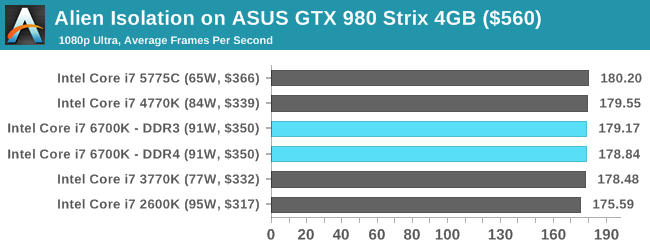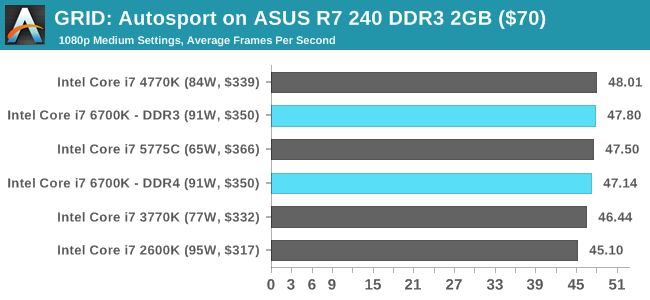The Intel 6th Gen Skylake Review: Core i7-6700K and i5-6600K Tested
by Ian Cutress on August 5, 2015 8:00 AM ESTComparing IPC on Skylake: Discrete Gaming
For this set of tests, we kept things simple – a low end single R7 240 DDR3, an ex-high end GTX 770 Lightning and a top line GTX 980 on our standard CPU game set under normal conditions. The IGP is not used here on the basis that each generation uses a substantially different integrated graphics arrangement.
Alien: Isolation
If first person survival mixed with horror is your sort of thing, then Alien: Isolation, based off of the Alien franchise, should be an interesting title. Developed by The Creative Assembly and released in October 2014, Alien: Isolation has won numerous awards from Game Of The Year to several top 10s/25s and Best Horror titles, ratcheting up over a million sales by February 2015. Alien: Isolation uses a custom built engine which includes dynamic sound effects and should be fully multi-core enabled.
For low end graphics, we test at 720p with Ultra settings, whereas for mid and high range graphics we bump this up to 1080p, taking the average frame rate as our marker with a scripted version of the built-in benchmark.



Total War: Attila
The Total War franchise moves on to Attila, another The Creative Assembly development, and is a stand-alone strategy title set in 395AD where the main story line lets the gamer take control of the leader of the Huns in order to conquer parts of the world. Graphically the game can render hundreds/thousands of units on screen at once, all with their individual actions and can put some of the big cards to task.
For low end graphics, we test at 720p with performance settings, recording the average frame rate. With mid and high range graphics, we test at 1080p with the quality setting. In both circumstances, unlimited video memory is enabled and the in-game scripted benchmark is used.



Grand Theft Auto V
The highly anticipated iteration of the Grand Theft Auto franchise finally hit the shelves on April 14th 2015, with both AMD and NVIDIA in tow to help optimize the title. GTA doesn’t provide graphical presets, but opens up the options to users and extends the boundaries by pushing even the hardest systems to the limit using Rockstar’s Advanced Game Engine. Whether the user is flying high in the mountains with long draw distances or dealing with assorted trash in the city, when cranked up to maximum it creates stunning visuals but hard work for both the CPU and the GPU.
For our test we have scripted a version of the in-game benchmark, relying only on the final part which combines a flight scene along with an in-city drive-by followed by a tanker explosion. For low end systems we test at 720p on the lowest settings, whereas mid and high end graphics play at 1080p with very high settings across the board. We record both the average frame rate and the percentage of frames under 60 FPS (16.6ms).



GRID: Autosport
No graphics tests are complete without some input from Codemasters and the EGO engine, which means for this round of testing we point towards GRID: Autosport, the next iteration in the GRID and racing genre. As with our previous racing testing, each update to the engine aims to add in effects, reflections, detail and realism, with Codemasters making ‘authenticity’ a main focal point for this version.
GRID’s benchmark mode is very flexible, and as a result we created a test race using a shortened version of the Red Bull Ring with twelve cars doing two laps. The car is focus starts last and is quite fast, but usually finishes second or third. For low end graphics we test at 1080p medium settings, whereas mid and high end graphics get the full 1080p maximum. Both the average and minimum frame rates are recorded.



Middle-Earth: Shadow of Mordor
The final title in our testing is another battle of system performance with the open world action-adventure title, Shadow of Mordor. Produced by Monolith using the LithTech Jupiter EX engine and numerous detail add-ons, SoM goes for detail and complexity to a large extent, despite having to be cut down from the original plans. The main story itself was written by the same writer as Red Dead Redemption, and it received Zero Punctuation’s Game of The Year in 2014.
For testing purposes, SoM gives a dynamic screen resolution setting, allowing us to render at high resolutions that are then scaled down to the monitor. As a result, we get several tests using the in-game benchmark. For low end graphics we examine at 720p with low settings, whereas mid and high end graphics get 1080p Ultra. The top graphics test is also redone at 3840x2160, also with Ultra settings, and we also test two cards at 4K where possible.





Conclusions on Gaming
There’s no easy way to write this.
Discrete graphics card performance decreases on Skylake over Haswell.
This doesn’t particularly make much sense at first glance. Here we have a processor with a higher IPC than Haswell but it performs worse in both DDR3 and DDR4 modes. The amount by which it performs worse is actually relatively minor, usually -3% with the odd benchmark (GRID on R7 240) going as low as -5%. Why does this happen at all?
So we passed our results on to Intel, as well as a few respected colleagues in the industry, all of whom were quite surprised. During a benchmark, the CPU performs tasks and directs memory transfers through the PCIe bus and vice versa. Technically, the CPU tasks should complete quicker due to the IPC and the improved threading topology, so that only leaves the PCIe to DRAM via CPU transfers.
Our best guess, until we get to IDF to analyze what has been changed or a direct explanation from Intel, is that part of the FIFO buffer arrangement between the CPU and PCIe might have changed with a hint of additional latency. That being said, a minor increase in PCIe overhead (or a decrease in latency/bandwidth) should be masked by the workload, so there might be something more fundamental at play, such as bus requests being accidentally duplicated or resent due to signal breakdown. There might also be a tertiary answer of an internal bus not running at full speed. To be sure, we rested some benchmarks on a different i7-6700K and a different motherboard, but saw the same effect. We’ll see how this plays out on the full-speed tests.















477 Comments
View All Comments
semyon95 - Wednesday, August 5, 2015 - link
DDR4 is completely useless and it will stay useless for a whileVlad_Da_Great - Wednesday, August 5, 2015 - link
DDR4 should be replaced with 3XP. The new memory from INTC/MU JV. Intel has foreseen that and perhaps next year CPUs models will have huge leap in performance.boeush - Thursday, August 6, 2015 - link
3dXP is much faster than NAND, but still nowhere near as fast as DRAM. So it will never replace DDR.boeush - Wednesday, August 5, 2015 - link
DDR4 is useless at 2133. It won't be quite as useless once 4000+ becomes the affordable norm. It'll take a year or two, but come 2017-18, DDR3 will be a clear-cut dinosaur. Of course, by then HBM 2 and maybe even 3 might be a compelling alternative - if not an upgradeable one...jjj - Wednesday, August 5, 2015 - link
Great , now cut the GPU and sell it at 60-80$ and it's all good.Until then, this is one of the biggest ripoffs in tech.
They do this instead of making a 60mm2 chip (without a GPU) that would cost them 10-20$ depending on yields and could easily retail well bellow 100$ even with their obscene margins. They just add bloat, in fact most of the chip is bloat, just to make it look like you are getting something worth paying for.
richardginn - Wednesday, August 5, 2015 - link
Why cut 80 bucks off it??? The broadwell i7-5775c CPU has GT3e graphics on it and would destroy the crap out of this Skylake CPU for Integrated graphics performance.Skylake is a full on total flop right now!!
Bambooz - Wednesday, August 5, 2015 - link
Except noone gives two sh*ts about integrated graphics when buying an i7..8steve8 - Wednesday, August 5, 2015 - link
I doTeknobug - Wednesday, August 5, 2015 - link
Unless it's in a mini PC type thing like the Gigabyte BRIX or Alienware Alpha. But no I don't buy i7's for its integrated GPU, just gonna say that high end CPU's shouldn't even include iGPU.nikaldro - Tuesday, August 11, 2015 - link
Still, the L4 cache can be useful, and DX12 could make use of both the GPU and iGPU to give better results.I mean, you're charging us 350 bucks, and I want the absolute cutting edge for that much, considering that by next year its 6 core counterpart will cost just a bit more, I think I'll just wait for the skylake E parts